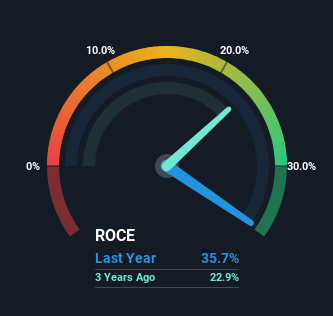
Did you know there are some financial metrics that can provide clues of a potential multi-bagger? Typically, we'll want to notice a trend of growing return on capital employed (ROCE) and alongside that, an expanding base of capital employed. Ultimately, this demonstrates that it's a business that is reinvesting profits at increasing rates of return. Looking at Illinois Tool Works (NYSE:ITW), it does have a high ROCE right now, but lets see how returns are trending.
What Is Return On Capital Employed (ROCE)?
Just to clarify if you're unsure, ROCE is a metric for evaluating how much pre-tax income (in percentage terms) a company earns on the capital invested in its business. Analysts use this formula to calculate it for Illinois Tool Works:
Return on Capital Employed = Earnings Before Interest and Tax (EBIT) ÷ (Total Assets - Current Liabilities)
0.36 = US$4.1b ÷ (US$15b - US$4.0b) (Based on the trailing twelve months to September 2023).
Therefore, Illinois Tool Works has an ROCE of 36%. In absolute terms that's a great return and it's even better than the Machinery industry average of 12%.
Check out our latest analysis for Illinois Tool Works

In the above chart we have measured Illinois Tool Works' prior ROCE against its prior performance, but the future is arguably more important. If you'd like to see what analysts are forecasting going forward, you should check out our free report for Illinois Tool Works.
How Are Returns Trending?
Things have been pretty stable at Illinois Tool Works, with its capital employed and returns on that capital staying somewhat the same for the last five years. This tells us the company isn't reinvesting in itself, so it's plausible that it's past the growth phase. So it may not be a multi-bagger in the making, but given the decent 36% return on capital, it'd be difficult to find fault with the business's current operations. This probably explains why Illinois Tool Works is paying out 49% of its income to shareholders in the form of dividends. Given the business isn't reinvesting in itself, it makes sense to distribute a portion of earnings among shareholders.
In Conclusion...
Although is allocating it's capital efficiently to generate impressive returns, it isn't compounding its base of capital, which is what we'd see from a multi-bagger. Although the market must be expecting these trends to improve because the stock has gained 100% over the last five years. However, unless these underlying trends turn more positive, we wouldn't get our hopes up too high.
On a separate note, we've found 1 warning sign for Illinois Tool Works you'll probably want to know about.
If you want to search for more stocks that have been earning high returns, check out this free list of stocks with solid balance sheets that are also earning high returns on equity.
New: AI Stock Screener & Alerts
Our new AI Stock Screener scans the market every day to uncover opportunities.
• Dividend Powerhouses (3%+ Yield)
• Undervalued Small Caps with Insider Buying
• High growth Tech and AI Companies
Or build your own from over 50 metrics.
Have feedback on this article? Concerned about the content? Get in touch with us directly. Alternatively, email editorial-team (at) simplywallst.com.
This article by Simply Wall St is general in nature. We provide commentary based on historical data and analyst forecasts only using an unbiased methodology and our articles are not intended to be financial advice. It does not constitute a recommendation to buy or sell any stock, and does not take account of your objectives, or your financial situation. We aim to bring you long-term focused analysis driven by fundamental data. Note that our analysis may not factor in the latest price-sensitive company announcements or qualitative material. Simply Wall St has no position in any stocks mentioned.
About NYSE:ITW
Illinois Tool Works
Manufactures and sells industrial products and equipment in the United States and internationally.
Established dividend payer with proven track record.


